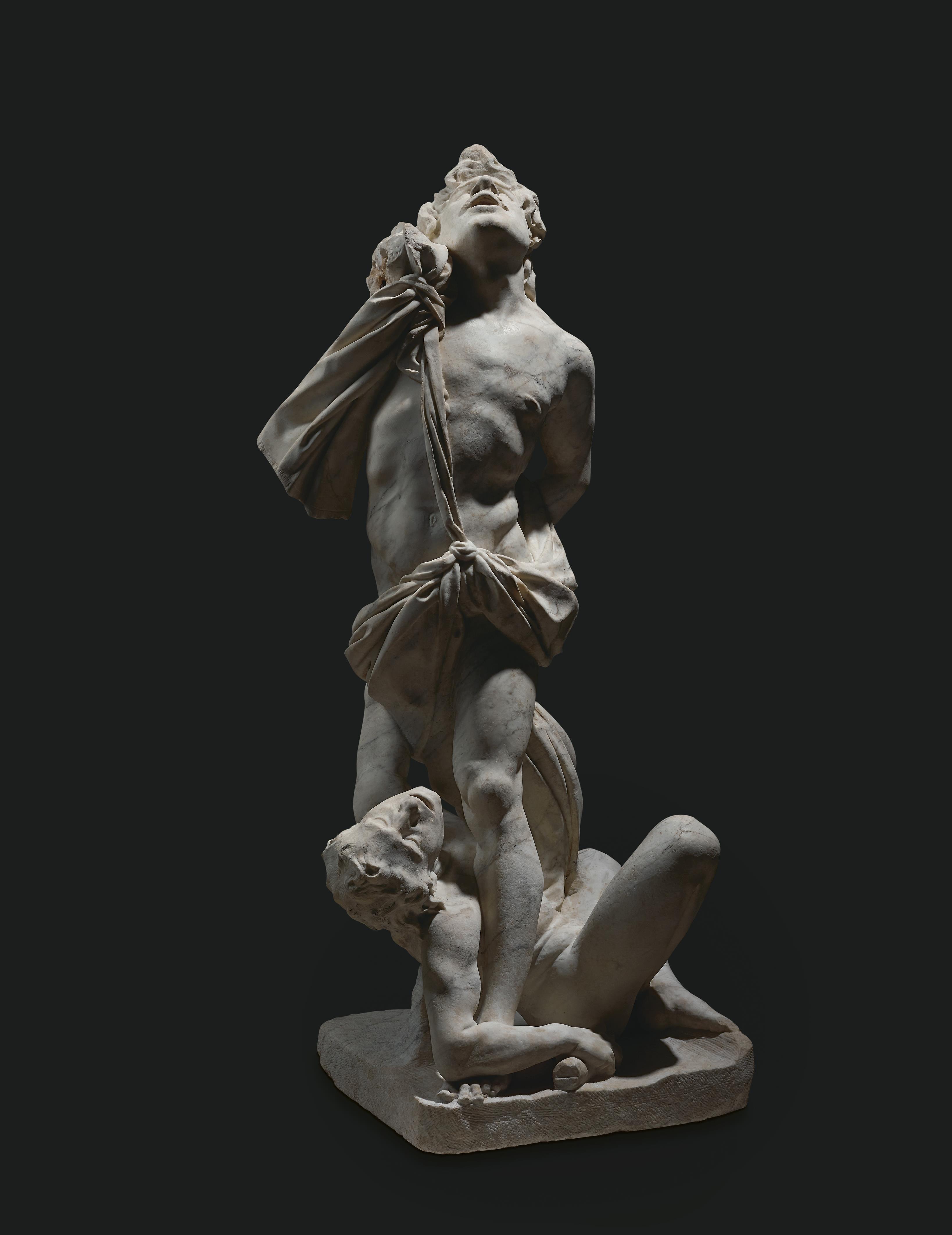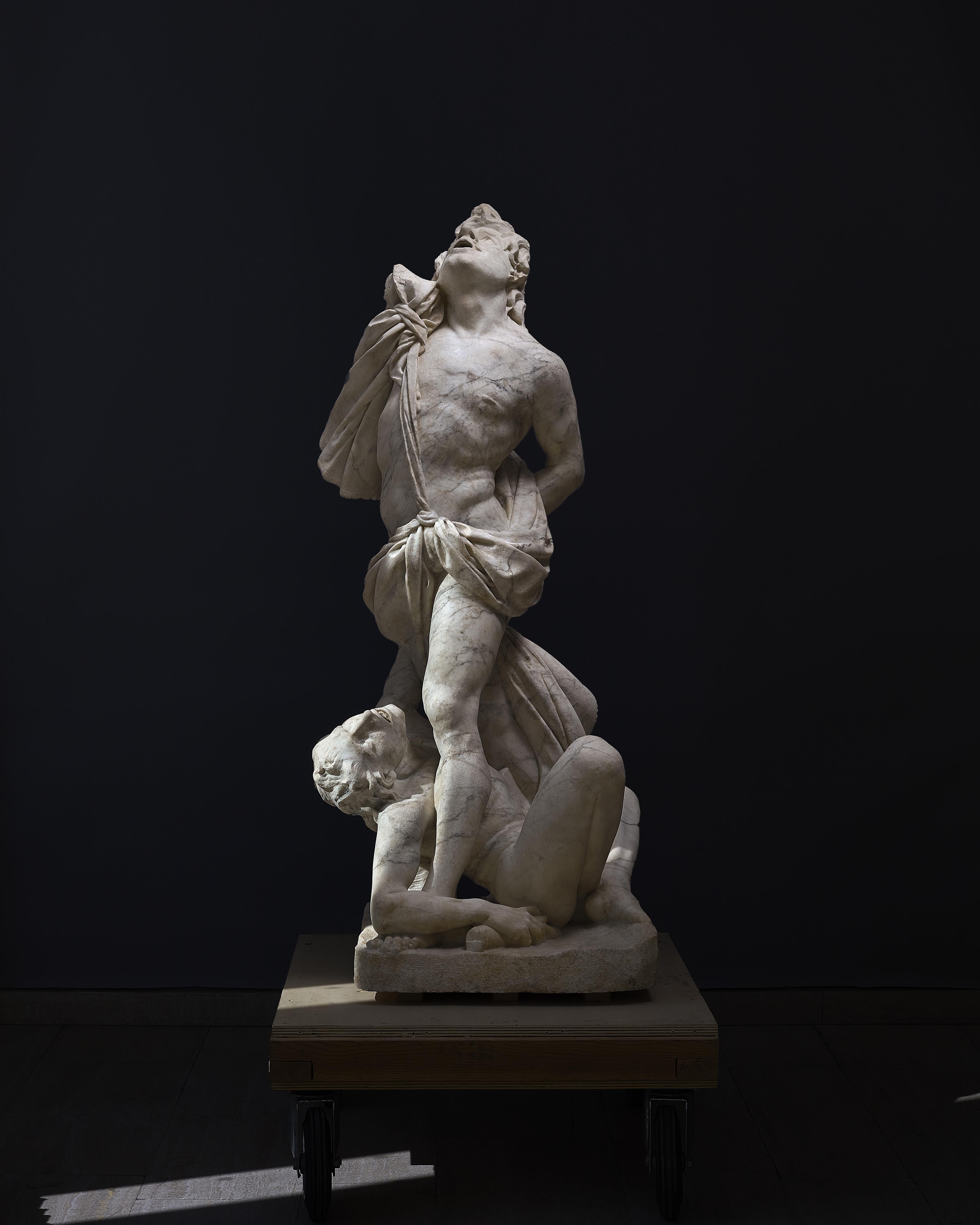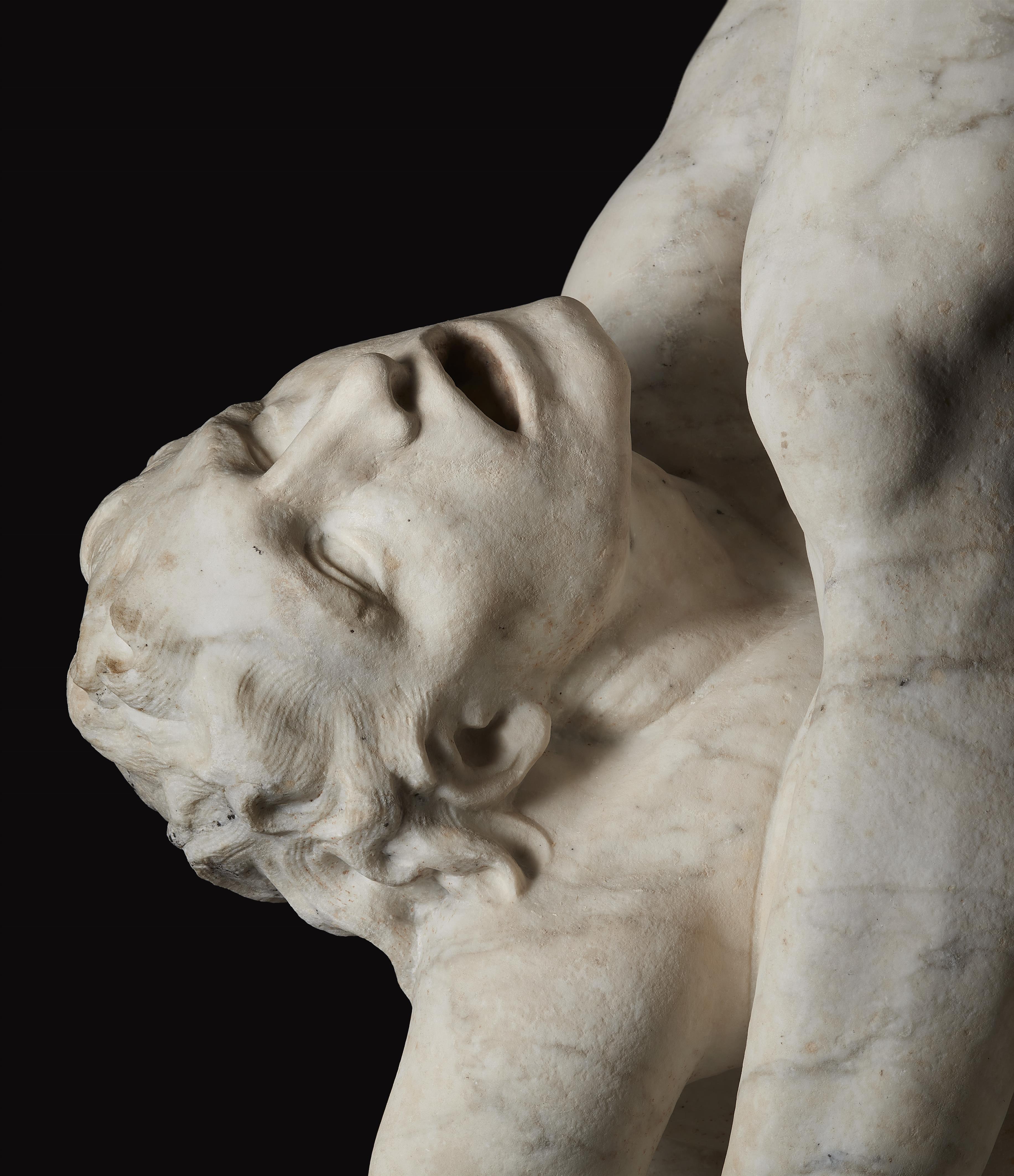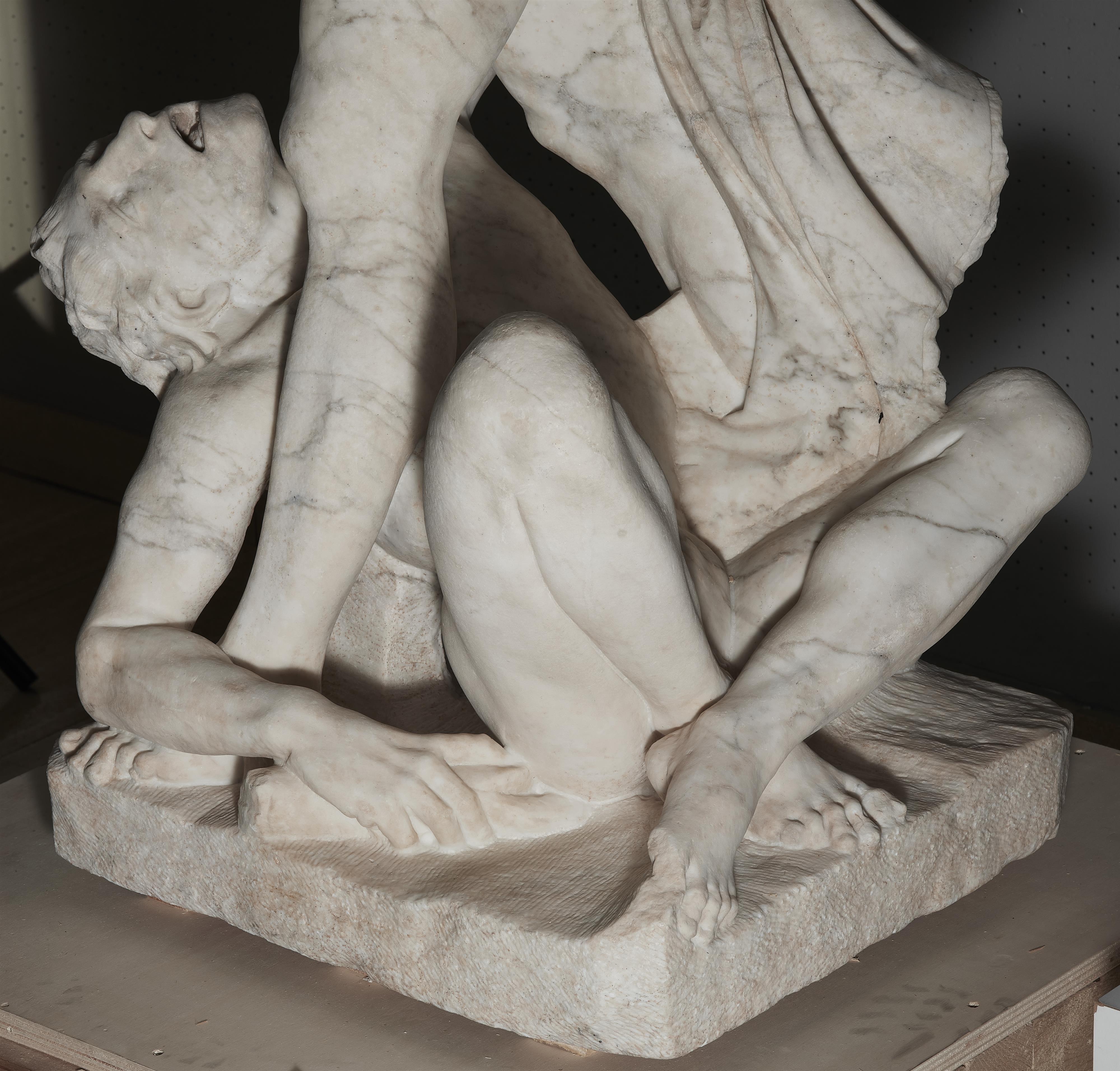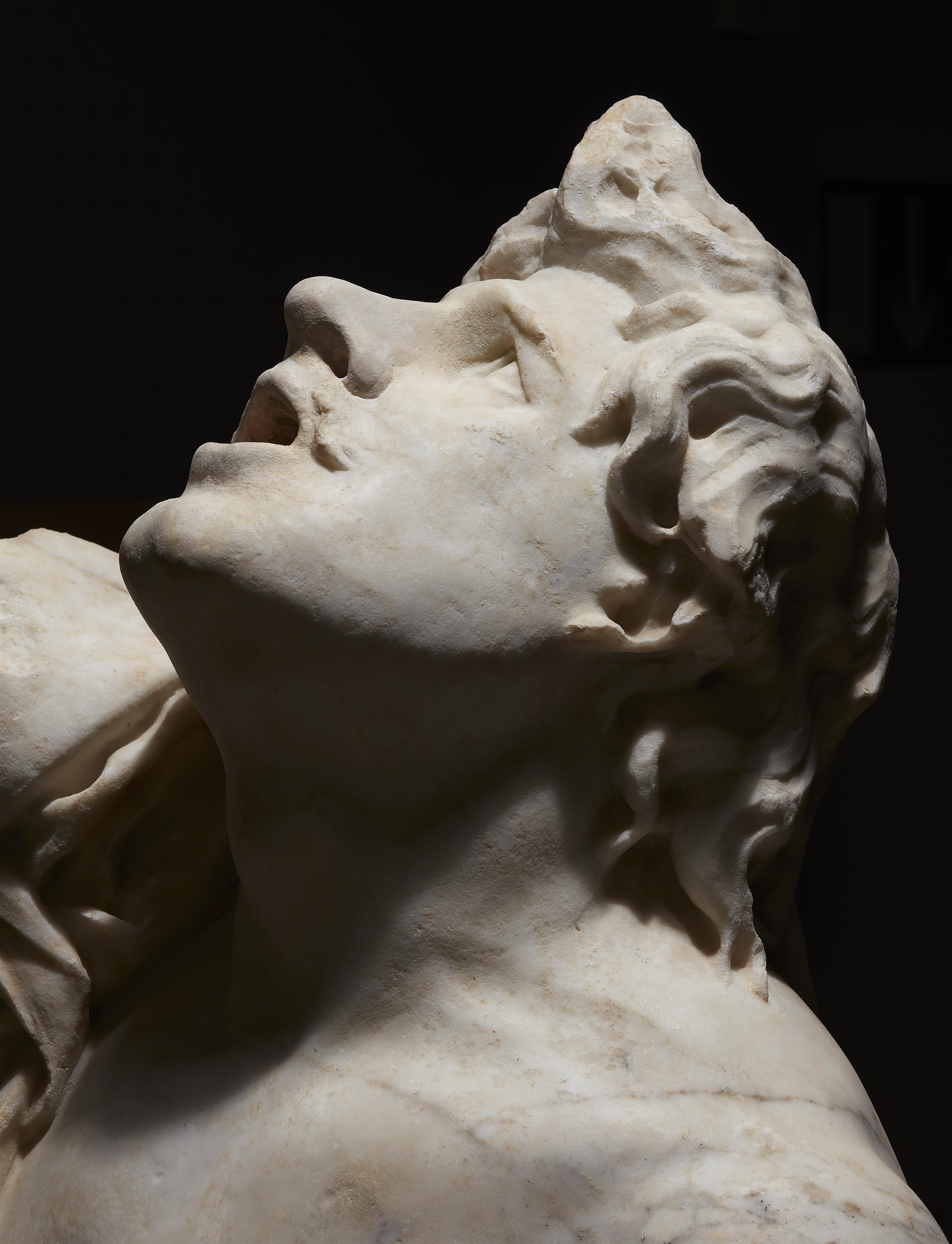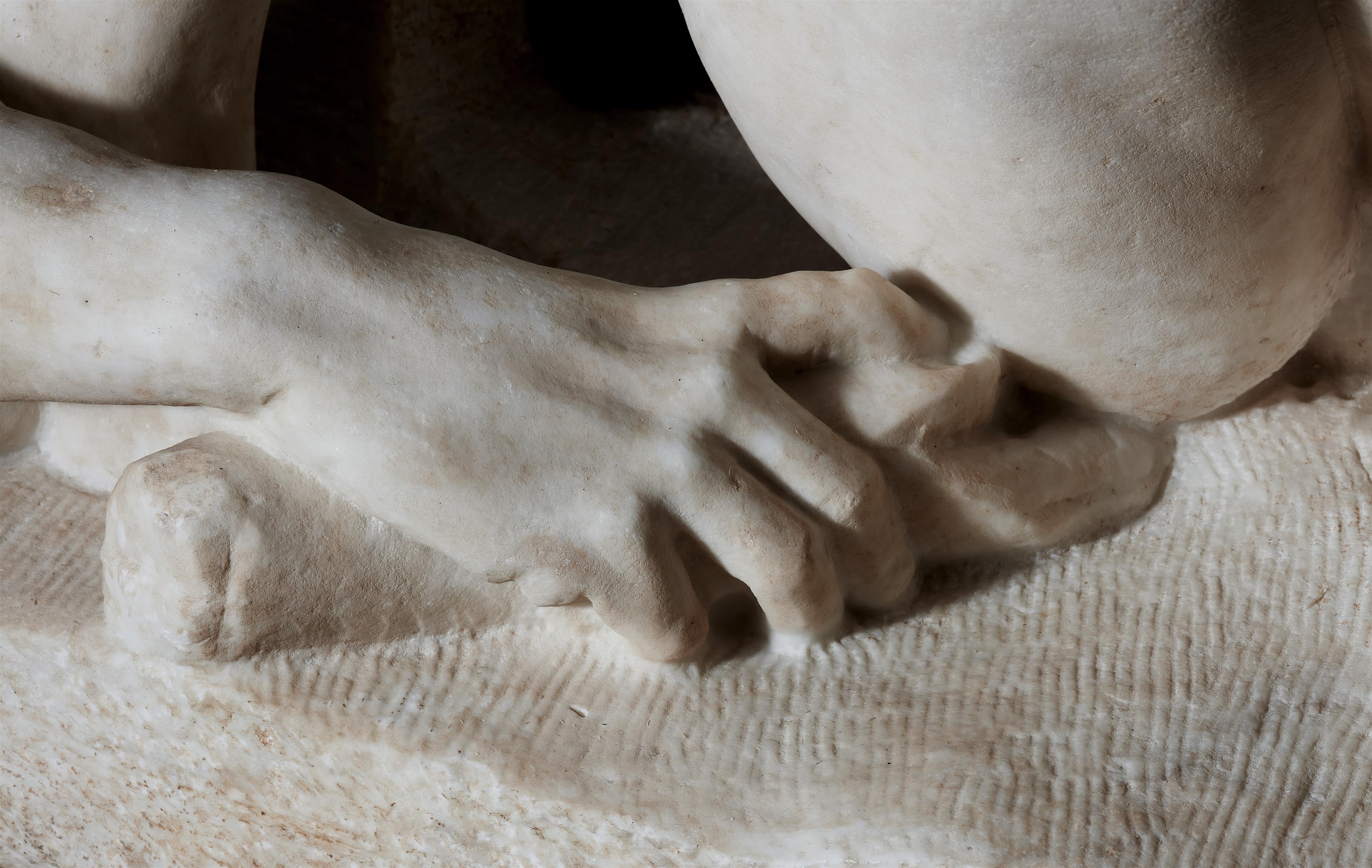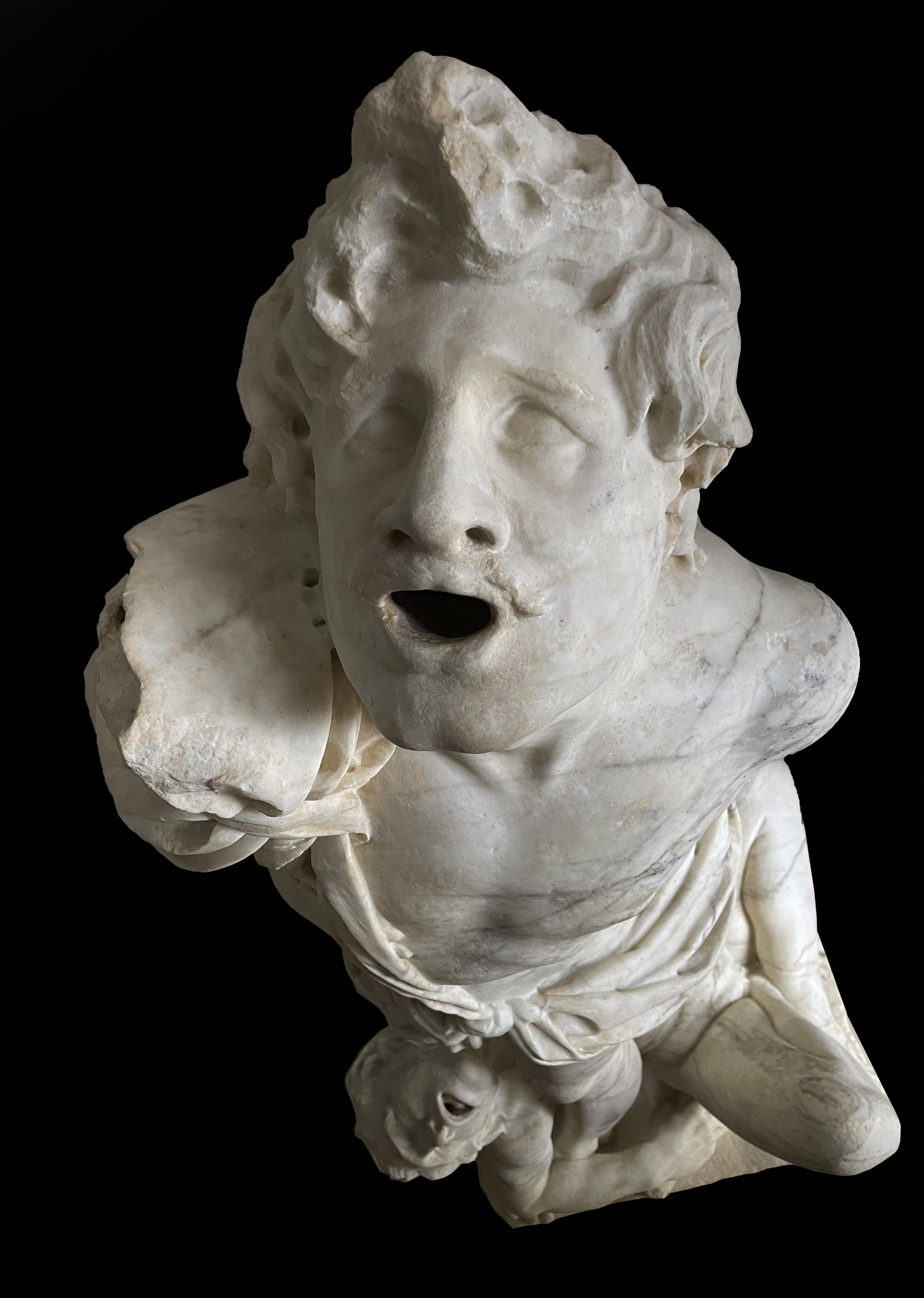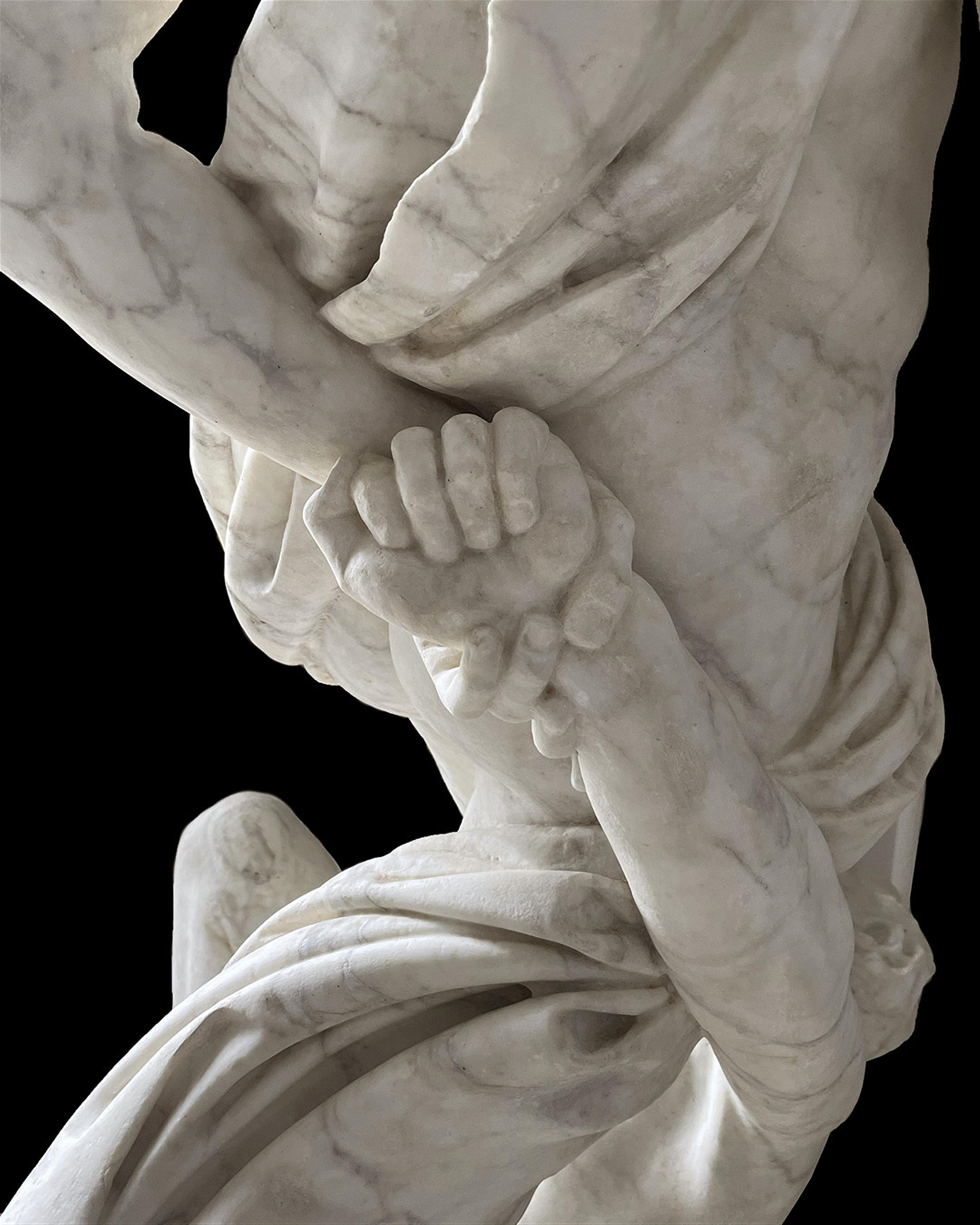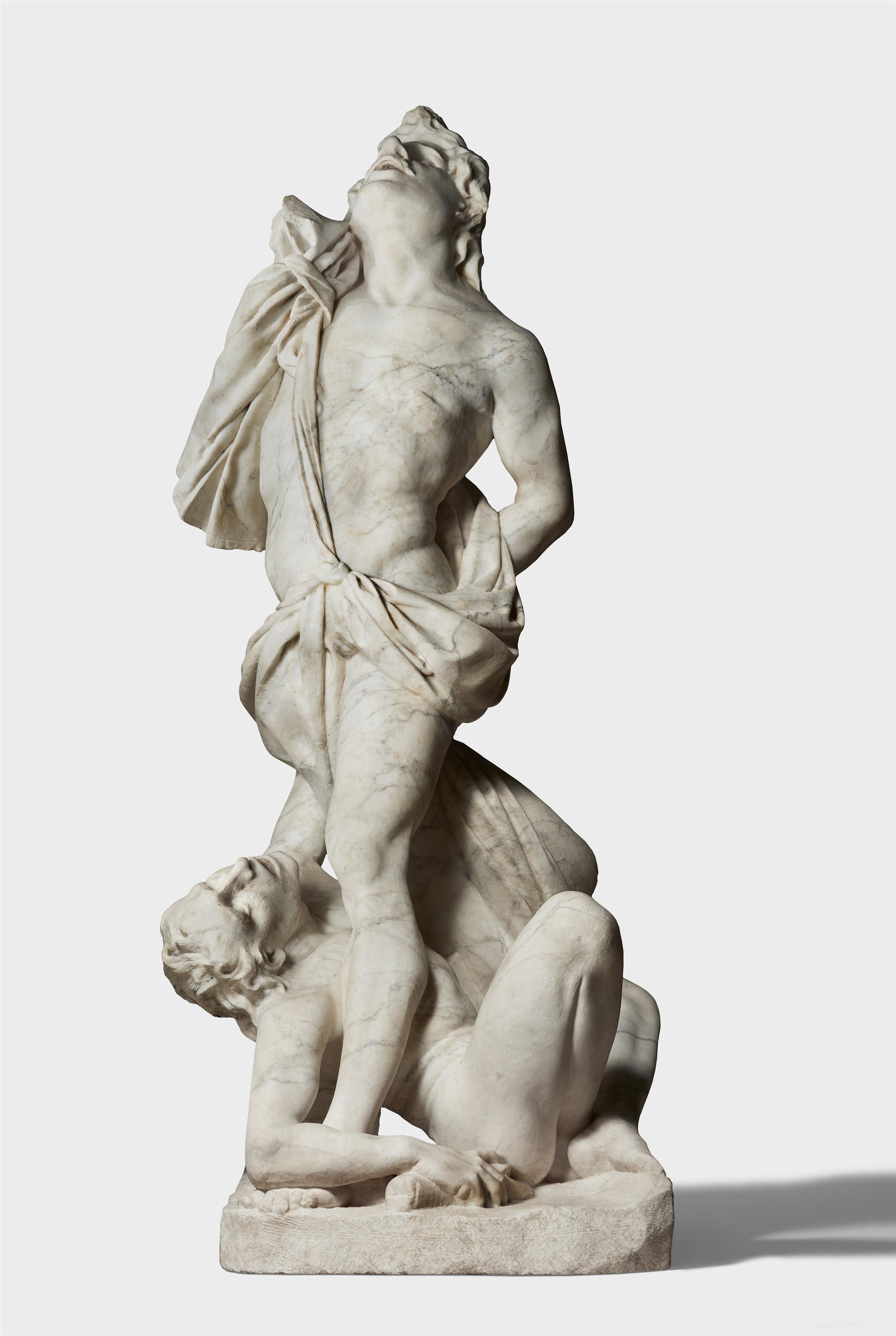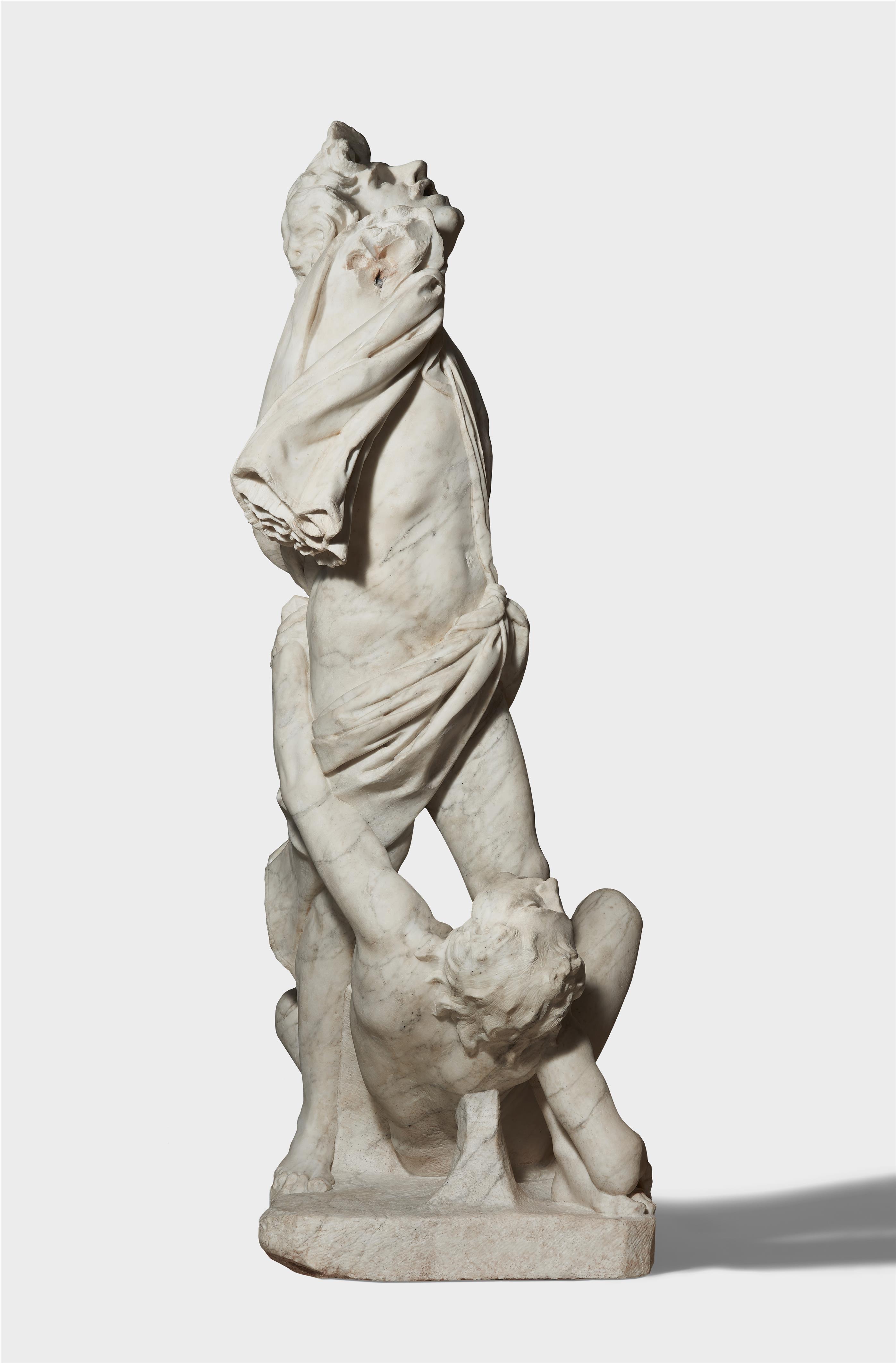Samson and the Philistine
by Pietro and Gian Lorenzo Bernini
White, grey veined marble. The formerly raised arm lost, minor loss to the toes. Restorations to the noses, the lips and the hands behind the back. H 151, plinth W 57, D 52 cm.
Rome, Pietro Bernini and Gian Lorenzo Bernini, ca. 1616 - 1618.
This work depicts the biblical figure of Samson who, according to an episode in the Old Testament, Book of Judges (Jg. 15:15-17), slew a thousand Philistines with the jawbone of an ass: "He found the still bloody jawbone of an ass, seized it with his hand and slew a thousand men with it. At that time Samson said, 'With the jawbone of an ass I have thoroughly beaten them; with the jawbone of an ass I have slain a thousand men.' When he had said this, he threw away the jawbone; hence the place was called Ramat Lehi (jawbone hill)." Instead of the presumably symbolic number of 1000 Philistines, a single Philistine is shown here, over whom the biblical hero triumphs.
The two-figure group is on a square flat plinth with chamfered corners. It is composed in such a way that it can be completely encircled and offers a new spectacular view from all sides.
A man with a girded robe and his head leant far back strides over an unclothed man lying on the ground with his back and legs bent. The victor grasps the wrist of the defeated man's clenched fist with his left hand behind his back and thus jerks him upwards to better hit him with the donkey's jawbone, unfortunately now lost. The sculptor had to provide the daring statics of his composition with a support, which he places under the back of the felled Philistine. The skilfully used structure of the grey-veined marble, with diagonal veins running from bottom left to top right, accentuates the dynamic composition. Thus, even without the lost raised arm with the jawbone, the narrative context is clearly recognisable.
The group was either conceived as part of a fountain or, in a later installation, fitted with pipes for a fountain. A lead pipe ends in the mouth of the Philistine, remains of a pipe are stuck in the shoulder of the broken arm. Unfortunately, since the arm is missing, it is not possible to say with certainty what the original intended first use was. It could be that the water was supposed to spring through the arm and that later - possibly after the arm broke - the group was modified and a channel was chiselled into the opening. This would explain why the channel does not open downwards but connects upwards. Moreover, a channel through the mouth of Samson seems to have been closed later.
The traditional attribution of this sculptural group was to the great architect, bronze caster and sculptor Pietro Tacca (1577 - 1640). Pietro Bernini was born in 1562 in Sesto Fiorentino, a town in the immediate vicinity of Florence, where he also received his first sculptural training. The "Tuscan matrix" has been preserved in his work and also finds expression here in the strongly curved body of the defeated man.
In the Staatliche Museen Berlin, Bode Museum Sculpture Collection there is another fountain depicting a satyr with a panther attributed to Pietro Bernini (inv. 292). At first glance, the use of the identically grained marble with its veins of pyrite and magnetite, which are similarly incorporated into the composition in Berlin, is striking. The posture of the Faun with his face turned upwards to the left and his raised arms, as well as his delicate torso, also reveal immediate parallels to the work here. Bacchi cites the 1999 conference at which the legendary American art historian Irving Lavin, on the basis of a document, predated the sculpture from the previously assumed year of 1615 to 1595 - 98 and located its production in Pietro Bernini's Florentine studio. At that time, Gian Lorenzo was not yet born or had just been born. Bacchi leaves this predating up to debate. Nevertheless, the common features of both sculptural groups remain recognisable despite the more weathered surface of the Samson.
In their expertise, Professor Angelini and Professor Maccherini compare this group with other early works by Gian Lorenzo such as the "Boy with Dragon", also a collaboration with his father, from the J. Paul Getty Museum (87.SA.42), the group "Faun teased by Children" in The Metropolitan Museum of Art Collection (1976.92), and the St. Lawrence/San Lorenzo of 1617 from the Uffizi (inv. Contini Bonacossi 36). In these sculptures, too, Gian Lorenzo's typical stylistic features can be noted, such as the similar use of the gradine, which is actually unusual in the Tuscan tradition, a "radial structure" of the hair and, unmistakably, a similar foot shape with the slightly extended thick toe.
In the past, not much attention was paid to the collaboration between Pietro and Gian Lorenzo. The early works of Gian Lorenzo have been neglected, even by contemporary biographers such as Baldinucci. Gian Lorenzo actively worked to create the myth of himself as enfant prodige and to hide his early activity in his father's workshop. That is why clear descriptions of how large a part the young Gian Lorenzo played in the oeuvre of his father's studio have been a source of art historical debate for decades. Andrea Bacchi dealt with this very theme in the catalogue of the exhibition "Gian Lorenzo Bernini. Regista del Barocco" at the Palazzo Venezia in Rome in 1999, and took it up again for the catalogue of the exhibition at the Villa Borghese in 2018 (op. cit., pp. 22). There is no doubt that Gian Lorenzo was already producing extraordinary works at the age of 17, but his roots in his father's workshop are nevertheless recognisable.
For this impressive group of Samson and the Philistine, the question of attribution remains open, although Alessandro Angelini and Michele Maccherini describe the contribution of the great Gian Lorenzo as significant.
Certificate
Alessandro Angelini and Michele Maccherini, Sansone e il filisteo di Gian Lorenzo e Pietro Bernini, 2003 (to be published).
Provenance
Albrecht Neuhaus, Würzburg.
European private collection.
Literature
Filippo Baldinucci, Vita del cavaliere G. Lorenzo Bernino, scultore, architetto, et pittore, Florence 1682.
Ursula Schlegel, Zum Oeuvre des jungen Gian Lorenzo Bernini, in: Jahrbuch der Berliner Museen 9/1967, p. 274-294.
Charles Avery, Bernini Genius of the Baroque, London 1997.
Alessandro Angelini, Gian Lorenzo Bernini e i Chigi tra Roma e Siena, Siena 1998.
Andrea Bacchi, Del conciliare l’inconciliabile. Da Pietro Bernini a Gian Lorenzo Bernini: commissioni, maturazioni stilistiche e pratiche di bottega, in: Bernardini/ Fagiolo Del'Arci (ed.), Gian Lorenzo Bernini regista del Barocco, catalogue of the exhibition, Milan 1999,
Hans-Ulrich Kessler, Pietro Bernini (1562 – 1629), Munich 2005.
Irving Lavin, Visible Spirit: The Art of Gianlorenzo Bernini, 2 Vol., London 2007 and 2009.
Andrea Bacchi/Anna Coliva (ed.), Bernini, Rome 2018.

